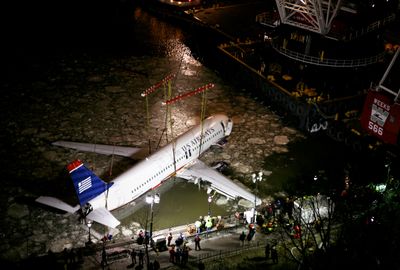Pilot picked spot in river near boats
‘Too low, too slow’ to go anywhere but into Hudson River

NEW YORK – The pilot of a crippled US Airways jetliner made a split-second decision to put down in the Hudson River because trying to return to the airport after birds knocked out both engines could have led to a “catastrophic” crash in a populated neighborhood, he told investigators Saturday.
Capt. Chesley B. “Sully” Sullenberger said he had little time to decide where to set down the powerless plane Thursday afternoon and that he felt it was “too low, too slow” and near too many buildings to go anywhere else, according to the National Transportation Safety Board account of his testimony.
The pilot and his first officer provided their first account to NTSB investigators Saturday of what unfolded inside the cockpit of US Airways Flight 1549 after it slammed into a flock of birds and lost power in both engines.
Late Saturday the airliner was hoisted from the water, carried by five large slings.
Co-pilot Jeff Skiles, who was flying the plane at takeoff, saw the birds coming in perfect formation, and made note of it. Sullenberger looked up, and in an instant his windscreen was filled with big, dark-brown birds.
“His instinct was to duck,” said NTSB board member Kitty Higgins, recounting their interview. Then there was a thump, the smell of burning birds, and silence as both aircraft engines cut out.
The account illustrated how quickly things deteriorated after the bump at 3,000 feet, and the pilots’ swift realization that returning to LaGuardia or getting to another airport was impossible.
With both engines out, Higgins said, flight attendants described complete silence in the cabin, “like being in a library.” A smoky haze and the odor of burning metal or electronics filled the plane.
The blow had come out of nowhere. The NTSB said radar data confirmed that the aircraft intersected a group of “primary targets,” almost certainly birds, as the jet climbed over the Bronx. Those targets had not been on the radar screen of the air traffic controller who approved the departure, Higgins said.
After the bird impact, Sullenberger told investigators he immediately took over flying from his co-pilot and made a series of command decisions.
Returning to LaGuardia, he quickly realized, was out. So was nearby Teterboro Airport, where he had never flown before, and which would require him to take the jet over densely populated northern New Jersey.
“We can’t do it,” he told air traffic controllers. “We’re gonna be in the Hudson.”
The co-pilot kept trying to restart the engines, while checking off emergency landing procedures on a three-page list that the crew normally begins at 35,000 feet.
Sullenberger guided the gliding jet over the George Washington Bridge and looked for a place to land.
Pilots are trained to set down near a ship if they have to ditch, so they can be rescued before sinking, and Sullenberger picked a stretch of water near Manhattan’s commuter ferry terminals. Rescuers were able to arrive within minutes.
It all happened so fast, the crew never threw the aircraft’s “ditch switch,” which seals off vents and holes in the fuselage to make it more seaworthy.
As the details of the river landing emerged Saturday, investigators struggled for most of the day with the logistics of pulling the airliner from the river next to a sea wall in lower Manhattan.
The mood on the shoreline turned festive in the late evening, as a crane successfully hoisted the submerged jet from the water.
The metal on the bottom of the craft appeared shredded and torn, and in some places it appeared to be shorn off.